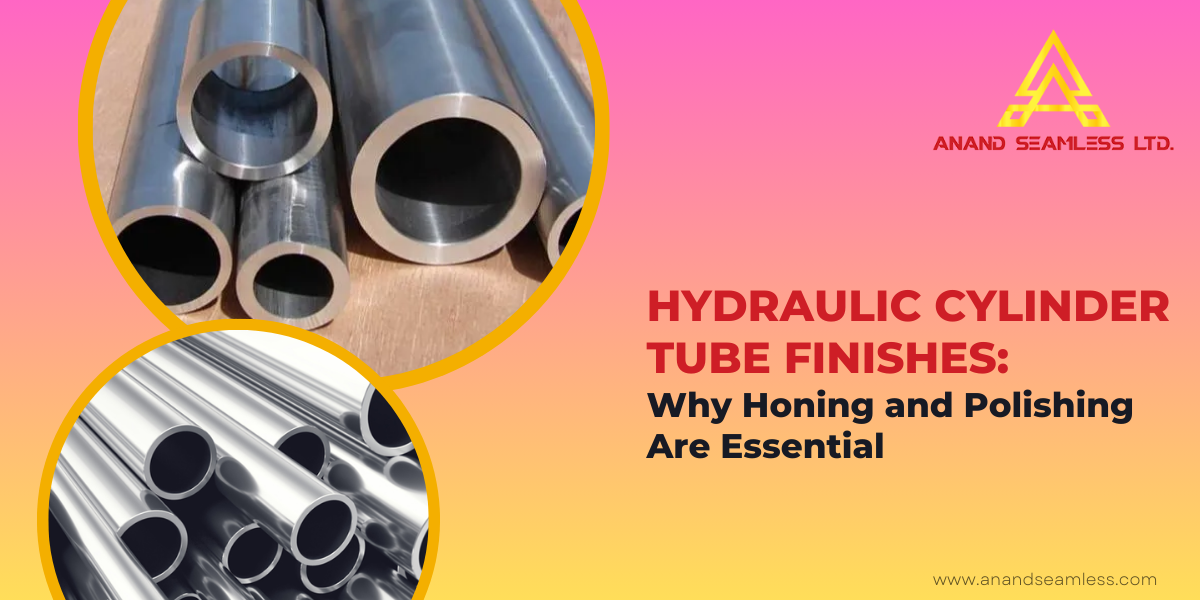Quick Inquiry
In hydraulic systems, efficiency and reliability are crucial. Cylinder tube, a type of hydraulic tube, is a core component in these systems. They must maintain precise control over fluid movement under high pressure. These tubes are essential in various industries, including heavy machinery, construction, agriculture, and mining. However, not all cylinder tubes perform equally, and a major differentiator is the tube’s surface finish. For businesses looking to maximise the effectiveness and longevity of their hydraulic systems, understanding the importance of surface finishes—specifically honing and polishing—is key.
The surface finish in cylinder tubes goes beyond appearance. It directly affects how well the cylinder performs, how efficiently it seals, and how long it lasts. For businesses operating these tubes, collaborating with reputable hydraulic cylinder tube manufacturers can make a significant difference.

Role of Surface Finishes in Hydraulic Cylinder Tubes
Impact on Cylinder Performance
A smooth and uniform surface finish in cylinder tubes is vital for optimal performance. When tubes undergo honing and polishing, it minimises surface irregularities, ensuring smoother piston movement. This controlled movement improves the efficiency of hydraulic systems and reduces friction. Less friction translates to less energy consumption, allowing hydraulic systems to operate more economically.
Influence on Sealing Effectiveness
Surface finishes are critical in forming effective seals within hydraulic systems. The smoother the tube’s surface, the easier it is to achieve tight seals, which prevents leaks and pressure loss. Honing and polishing help create a finish that balances smoothness with enough surface texture to maintain lubricant retention, ensuring efficient sealing under high pressure.
Durability and Lifespan of the Cylinder
A superior surface finish contributes to the durability of hydraulic cylinder tubes. By reducing surface defects and friction, honing and polishing reduce wear and tear on both the tube and seals. This, in turn, extends the life of the cylinders, decreasing the frequency of maintenance and replacements and enhancing the value for end users.
Honing Process
Definition and Purpose of Honing
Honing is a specialised machining process designed to refine the internal surface of cylinder tubes. It involves using abrasive stones or grit to polish and smooth the tube’s interior, creating a uniform, precise surface finish. For hydraulic cylinder tube manufacturers, honing is a critical step in producing high-quality tubes that meet the performance demands of hydraulic systems. This process ensures that tubes are not only smooth but also dimensionally accurate, making them suitable for applications where precision and durability are essential.
Key Benefits of Honing
Precision Sizing
Honing enables tight tolerances in cylinder tubes, which is crucial for achieving an exact fit with pistons and other moving parts within hydraulic systems. This precision sizing is especially valuable for businesses where hydraulic cylinders need to operate under high pressure without deviations in performance.
Surface Smoothness
The honing process creates a smooth and consistent surface texture, essential for reducing friction and wear. In hydraulic applications, this smoothness improves the efficiency of fluid movement and reduces energy loss. A polished surface also helps minimise abrasion on seals and other internal components, extending the lifespan of the tube and the overall system.
Removal of Imperfections
During manufacturing, small surface defects like scratches or irregularities can occur within tubes. Honing removes these imperfections, resulting in a cleaner, more refined tube interior. By eliminating these minor flaws, honing enhances the reliability of hydraulic systems by reducing the risk of failure or performance issues.
Typical Applications
- Used in high-performance hydraulic systems across industries like construction, mining, and heavy machinery.
- Essential for hydraulic cylinders in industrial equipment requiring precise fluid control.
- Ideal for applications demanding extreme durability and efficiency in harsh operating environments.
- Beneficial for hydraulic systems needing minimised friction and optimised seal compatibility.
Contact Us for Customised Tubes!
Polishing Process
Definition and Purpose of Polishing
Polishing is the final stage in finishing hydraulic cylinder tubes, designed to create an ultra-smooth, reflective surface. After honing, polishing further refines the interior of the tube, removing any remaining roughness or micro-scratches. For manufacturers, polishing is a critical step, as it improves both the performance and longevity of the tubes. This process results in an extremely smooth finish, which is ideal for hydraulic systems where precision and minimal friction are essential.
Key Benefits of Polishing
Enhanced Surface Finish
Polishing achieves an even smoother, more refined surface than honing alone. This helps hydraulic cylinders operate seamlessly by reducing roughness that could impact fluid flow. For businesses, this means improved efficiency and consistent performance in hydraulic applications.
Reduction of Friction
Polishing minimises internal friction within the tube, allowing for smoother piston movement. Lower friction reduces energy consumption and decreases wear on seals and other components, extending the life of the hydraulic system.
Increased Wear Resistance
A polished surface is more resistant to wear, which is critical in demanding environments. By reducing the abrasive impact on the interior of the cylinder tube, polishing contributes to the overall durability, making it an ideal choice for heavy-duty applications.
Role in Reducing Contamination and Corrosion
Polishing helps to seal micro-pores in the metal, making it more resistant to contaminants and moisture. This protective finish reduces the risk of corrosion, ensuring cleaner operations and reducing the potential for system failure due to contamination.
Comparison of Honing vs. Polishing
Differences in Techniques and Outcomes
Honing and polishing are distinct techniques that together create an optimal surface for hydraulic cylinder tubes. Honing uses abrasive stones or grit to remove surface imperfections, resulting in precise sizing and a moderately smooth finish. This process is more about dimensional accuracy and removing surface defects. Polishing, on the other hand, focuses on achieving a mirror-like, ultra-smooth finish, eliminating any residual micro-scratches and further refining the tube surface. While honing provides a solid base for efficient performance, polishing brings the final level of smoothness and durability.
When to Use Honing vs. Polishing
Honing is generally the primary process and is essential when the tube requires strict tolerances and the removal of manufacturing irregularities. It is particularly useful for tubes where piston movement precision is crucial. Polishing, however, is ideal for applications where minimising friction and enhancing wear resistance are key. It is often the final step, following honing, to further elevate surface quality and protect the tube against wear and corrosion.
Combined Effect of Both Processes
The combined effect of honing and polishing provides cylinder tubes with enhanced performance and durability. Honing establishes dimensional accuracy and a smooth initial surface, while polishing creates the final, reflective finish that minimises friction, reduces wear, and improves corrosion resistance. Together, these processes ensure the tubes are optimised for high-performance and long-lasting applications across industries.
Importance of Quality Control in Surface Finishing
Quality control is essential in ensuring that cylinder tubes achieve the high-performance surface finishes necessary for demanding applications. Here’s how it impacts production:
Monitoring Surface Texture and Roughness
- Surface texture and roughness are critical to cylinder performance, as even minor variations can affect hydraulic efficiency and durability.
- Quality control processes ensure consistency by closely monitoring these aspects, helping tubes withstand high-pressure conditions effectively.
Tools and Techniques for Ensuring High-Quality Finishes
- Profilometers: Used to measure surface roughness and check if it meets tolerance levels.
- Microscopic Analysis and Non-Destructive Testing: These methods allow in-depth inspections of the surface quality without damaging the tube. They enable early identification of imperfections.
Industry Standards for Hydraulic Cylinder Tubes
- Hydraulic cylinder tube manufacturers adhere to strict industry standards like ISO and ASTM to ensure product reliability and safety.
- Meeting these standards is vital for producing consistent, high-quality tubes that can withstand rigorous use.
Impact on Performance and Efficiency
High-quality surface finishes have a direct impact on the performance and efficiency of hydraulic cylinders:
Enhanced Sealing and Hydraulic Efficiency
- Finely honed and polished surfaces improve sealing, reducing the risk of fluid leakage and maintaining stable pressure.
- Better sealing also prevents contamination, which can degrade system performance over time.
Improved Long-Term Performance and Reduced Maintenance Costs
- Quality surface finishes reduce internal friction and wear, extending cylinder life and minimising the need for frequent maintenance.
- This leads to lower maintenance costs, reduced downtime, and increased efficiency—particularly valuable for businesses in demanding environments.
FAQs
For how long should you hone a cylinder?
The time required for honing a cylinder depends on the material and the level of surface smoothness desired. Typically, honing takes a few minutes to achieve the right finish, but for extremely precise finishes, it may take longer. Consistent inspection is important to avoid over-honing, which could lead to unwanted wear.
Does honing increase bore size?
Yes, honing can slightly increase the bore size of a cylinder. The process removes a small layer of material, refining the diameter to ensure an accurate fit with the piston. However, experienced hydraulic cylinder tube manufacturers control this process to achieve precise dimensions within the required tolerance.
Is it advisable to use oil when honing a cylinder?
Yes, honing oil is essential during the honing process. It reduces friction, keeps the honing stone from overheating, and helps remove small metal particles. Using oil enhances the quality of the finish, making the process smoother and more effective.
How much metal is removed when honing a cylinder?
Honing typically removes a very small amount of material, usually between 0.01 to 0.03 mm. The exact amount depends on the cylinder’s condition and the desired finish. It’s a controlled process, ensuring that only the necessary amount is removed to achieve optimal surface texture.
Which oil is best for honing a cylinder?
Specialised honing oils are recommended, as they are formulated to provide the right level of lubrication. These oils also prevent clogging and keep the honing stones clean, ensuring a more efficient process.
Do you need a new piston after honing?
Not necessarily. If the honing process removes only a minimal amount, the existing piston can still fit. However, if substantial material is removed, piston size should be checked to ensure a proper seal and fit.
Can honing improve the lifespan of a cylinder tube?
Yes, honing enhances the lifespan of a hydraulic cylinder tube by creating a smooth, precise surface that reduces friction and wear. This helps maintain effective sealing, prevents leaks, and minimises the risk of damage, leading to fewer breakdowns and lower maintenance costs.
Get High-Quality Hydraulic Cylinder Tubes for Maximum Performance
Ensure the longevity and efficiency of your hydraulic systems with premium hydraulic cylinder tubes. At Anand Seamless Limited, we specialise in manufacturing precision-engineered cylinder tubes, designed to meet the highest standards of performance. Our expert honing and polishing processes guarantee smooth surfaces, optimal sealing, and reduced friction, enhancing the lifespan of your equipment.
Whether you’re in construction, agriculture, or heavy machinery, our tubes are tailored for maximum durability and reliability. By partnering with a trusted hydraulic cylinder tube manufacturer like us, you’ll experience improved efficiency, reduced maintenance costs, and fewer downtime incidents.
Contact us today at +91-9099996854 or mail us at inquiry@anandseamless.com to learn more about how our high-quality cylinder tubes can improve your operations. Let us provide you with the precision and performance you deserve. Reach out now for a consultation or a quote!
lATEST BLOG |
|
The Impact of Tube Fin Design on Heat Transfer Performance
Finned tubes are essential in industries like powe |
|
U-Tube vs. Straight-Tube Heat Exchangers: Comparison Guide
Heat exchangers play a crucial role in industries |
|
Destructive vs. Non-Destructive Testing for Seamless Tubes
Seamless tubes play a critical role in industries |
|
The Hidden Costs of Poor-Quality Heat Exchanger Tubes: A Manufacturer’s Perspective
Heat exchangers play a critical role in various in |
|
Seamless Tubes in Boiler and Power Plants: Why They Are a Game-Changer
Seamless tubes are crucial in various industrial a |

